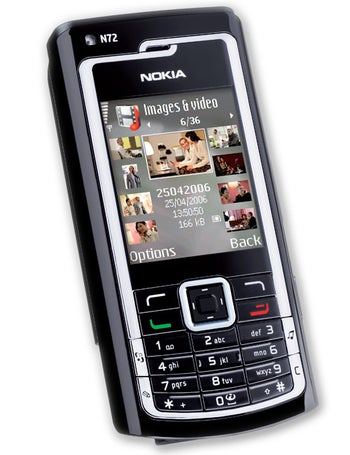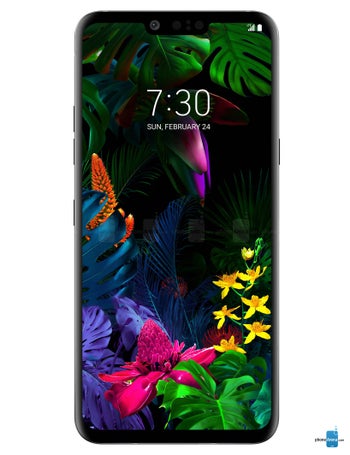Nokia N72 vs LG G8 ThinQ Specs Comparison
Compare mobile phone specifications of up to three devices at once. Our specs comparison tool helps you find and compare the perfect phone for your needs.
|
|
|
| Nokia N72 | LG G8 ThinQ |
|
970 mAh
|
3500 mAh
|
|
208x176px
|
6.1-inch · 3120x1440px
|
|
Single camera
|
Dual camera
|
|
0.02GB
|
6GB · 128GB
|
|
Released
·
Apr 11, 2019
|
|
| Check prices |
Design
| Dimensions | |
|---|---|
| 4.28 x 2.10 x 0.68 inches 109 x 53.5 x 17.5 mm |
5.98 x 2.83 x 0.33 inches 151.9 x 71.8 x 8.4 mm |
| Weight | |
| 4.37 oz (124.0 g) | 5.89 oz (167.0 g) |
| Materials | |
| Back: Glass (Corning Gorilla Glass 6) Frame: Aluminum |
|
| Resistance | |
| Water, Dust; IP68; MIL-STD-810 certified | |
| Biometrics | |
| 3D Face unlock, Fingerprint (touch) | |
| Features | |
| Numeric keypad, Soft keys | |
| Keys | |
| Right: Camera shutter | Left: Volume control; Right: Lock/Unlock key |
| Colors | |
| Aurora black, Platinum gray, Carmine red | |
Display
| Size | |
|---|---|
| 6.1-inch | |
| Resolution | |
| 208x176px | 3120x1440px, 19.5:9 ratio, 563 PPI |
| Technology | |
| TFT | OLED |
| Screen-to-body | |
| 83.66 % | |
| Colors | |
| 262 144 | |
| Peak brightness | |
| 600 cd/m2 (nit) | |
| Features | |
| HDR support, Scratch-resistant glass (Corning Gorilla Glass 5), Ambient light sensor, Proximity sensor | |
Hardware
| System chip | |
|---|---|
| Qualcomm Snapdragon 855 (7 nm) | |
| Processor | |
| Octa-core 2840 MHz Kryo 485 |
|
| GPU | |
| Adreno 640 | |
| RAM | |
| 6GB (LPDDR4) | |
| Internal storage | |
| 0.02GB | 128GB, available to use: 106 GB |
| Storage expansion | |
| RS-MMC | microSDXC up to 2000 GB |
| OS | |
| Symbian (8.1) | Android (9.0 Pie) |
Battery
| Capacity | |
|---|---|
| 970 mAh | 3500 mAh |
| Type | |
| Li - Ion | Li - Polymer |
| Charging | |
| Qualcomm Quick Charge 3.0, USB Power Delivery, Qi wireless charging | |
Camera
| Rear | |
|---|---|
| Single camera | Dual camera |
| Main camera | |
| 2 MP | 12 MP (OIS, PDAF) Aperture size: F1.5 Focal length: 27 mm Sensor size: 1/2.6" Pixel size: 1.4 μm |
| Second camera | |
| 16 MP (Ultra-wide) Aperture size: F1.9 Focal Length: 16 mm Sensor size: 1/3.1" Pixel size: 1 μm |
|
| Flash | |
| LED | LED |
| Video recording | |
| 352x288 (CIF) | 3840x2160 (4K UHD) (60 fps), 1920x1080 (Full HD) (60 fps), 1280x720 (HD) (240 fps) HDR, Time-lapse video, EIS, Video calling, Video sharing |
| Front | |
| 8 MP (Dual-Camera, Autofocus), Video capture: 1920x1080 (Full HD) | |
Connectivity & Features
| Bluetooth | |
|---|---|
| 2.0 | 5.0 |
| WLAN | |
| 802.11 a,b,g,n,ac,dual-band MIMO, Wi-Fi Direct, Hotspot |
|
| USB | |
| Proprietary, USB 2.0 | Type-C, USB 3.1 |
| Hearing aid compatible | |
| M4/T3 | |
| Location | |
| GPS, A-GPS, Glonass, Cell ID, Wi-Fi positioning | |
| Sensors | |
| Accelerometer, Gyroscope, Compass, Barometer | |
| Other | |
| Computer sync, SyncML | NFC, UMA (Wi-Fi Calling) |
Multimedia
| Headphones | |
|---|---|
| 3.5mm jack | |
| Speakers | |
| Earpiece, Multiple speakers | |
| Features | |
| 32-Bit DAC, DTS:X Virtual Surround, aptX-HD | |
| Screen mirroring | |
| DLNA,Wireless screen share,MirrorLink | |
| Radio | |
| FM | FM |
| Additional microphone(s) | |
| Noise cancellation, Video recording | |
Cellular
| 4G (FDD) | |
|---|---|
| Bands 1(2100), 2(1900), 3(1800), 4(AWS-1), 5(850), 7(2600), 8(900), 12(700 a), 13(700 c), 14(700 PS), 17(700 b), 20(800 DD), 25(1900+), 26(850+), 28(700 APT), 29(700 d), 30(2300 WCS), 66(AWS-3), 71(600) | |
| 4G (TDD) | |
| Bands 38(2600), 39(1900+), 40(2300), 41(2600+), 46 | |
| 3G | |
| Bands 1(2100), 2(1900), 4(1700/2100), 5(850), 8(900) | |
| Data Speed | |
| LTE-A Pro Cat 20 (2000/150 Mbit/s), HSDPA+ (4G) 42.2 Mbit/s, HSUPA 5.76 Mbit/s | |
| SIM type | |
| Nano SIM | |
| HD Voice | |
| Yes | |
Phone Features
| Notifications | |
|---|---|
| Music ringtones (MP3), Polyphonic ringtones (64 voices), Vibration, Phone profiles, Speakerphone | |
| Other features | |
| Voice dialing, Voice commands, Voice recording, Push-to-Talk | |
Regulatory Approval
| FCC approval | |
|---|---|
| Date approved: Mar 30, 2006 FCC ID value: QFXRM-180 | Date approved: Feb 15, 2019 FCC ID value: ZNFG820UM |
| Measured SAR | |
| Head: 0.40 W/kg Measured in: 1900 MHz Body: 0.69 W/kg Measured in: 1900 MHz |
Head: 0.98 W/kg Body: 0.95 W/kg Simultaneous Transmission: 1.59 W/kg Wireless Router: 1.29 W/kg Phablet: 3.88 W/kg |
| EU SAR | |
| Head: 0.76 W/kg | |
Buyers information
| MSRP | |
|---|---|
| $ 820 | |
| In The Box | |
| USB Type-C cable, Quick Charge 3.0 charger, SIM tray opener, Clear case, Stereo headset | |
Availability
| Officially announced | |
|---|---|
| Apr 25, 2006 | Feb 24, 2019 |
Alternative variants
Dual SIM
| Dual SIM | Yes |
|---|---|
for T-Mobile
| OS | Android (10) |
|---|---|
| 4G (FDD) | Bands 1(2100), 3(1800), 7(2600), 8(900), 13(700 c), 20(800 DD), 25(1900+), 26(850+), 28(700 APT) |
for Sprint
| OS | Android (10) |
|---|---|
| 4G (FDD) | Bands 1(2100), 2(1900), 3(1800), 4(AWS-1), 5(850), 7(2600), 8(900), 12(700 a), 13(700 c), 17(700 b), 20(800 DD), 25(1900+), 26(850+), 28(700 APT), 66(AWS-3), 71(600) |
| 4G (TDD) | Bands 40(2300), 41(2600+), 46 |
for AT&T
| 4G (FDD) | Bands 1(2100), 2(1900), 3(1800), 4(AWS-1), 5(850), 7(2600), 12(700 a), 14(700 PS), 20(800 DD), 29(700 d), 30(2300 WCS), 66(AWS-3) |
|---|---|
| 3G | Bands 5(850), 4(1700/2100), 2(1900), 1(2100) |
for Verizon Wireless
| OS | Android (10) |
|---|---|
| 4G (FDD) | Bands 2(1900), 3(1800), 4(AWS-1), 5(850), 7(2600), 13(700 c), 20(800 DD), 28(700 APT), 66(AWS-3) |
| 4G (TDD) | Bands 46, 48(3600) |
| 3G | Bands 5(850), 8(900), 2(1900), 1(2100) |
Links
| Full specifications | |
|---|---|
| Nokia N72 Specs | LG G8 ThinQ Specs |
| PhoneArena Review | |
| LG G8 ThinQ Review | |
| User Reviews | |
| Nokia N72 User Reviews | LG G8 ThinQ User Reviews |


